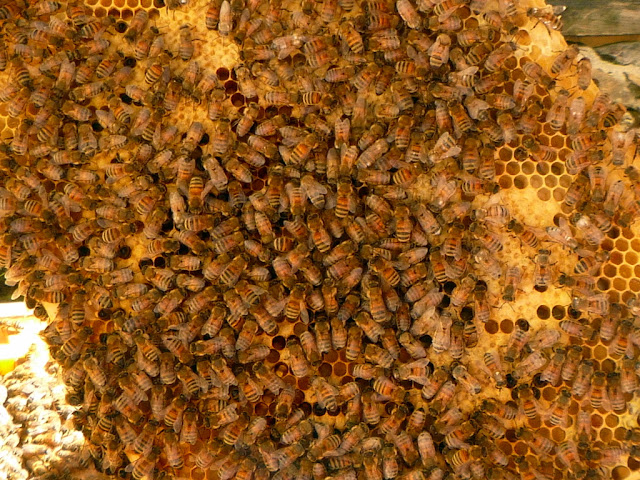Nice weather this Saturday morning, and more than time I had another check on the bees. I also wanted to dust them with icing sugar which is futher supposed to help them clear the varroa mites. - I think the reasoning is that they 'groom' each other and pull off some of the mites. - Also, I guess the sugar might irritate the mites and cause them to fall off. Certainly, the varroa board had a lot of 'live' mites on it after I'd dusted the bees - these I disposed of well away from the hive, and left the board off. I'll leave the bottom open for a few days and then check the mite drop properly to get a better picture of how it's going.
Something I read said you should always have a plan when opening the hive - a reason for doing so. Well, today I really just wanted to check that all was in order and dust the bees with icing sugar - that was the plan.
Little smoke to let them know we are coming.
Working down through the hive - they've taken about half of the Apiguard, or it's evaporated - hopefully the large number of mites on the drop board shows they are dying.
Looks like they are filling the upper super with syrup, and some brood too - as expected. They still haven't filled the outer couple of frames but maybe they will - they have about a month yet before the start of winter.
Working through the super, I sprinkled the bees with icing sugar as I went. Here's a pretty full frame from the super.
Moving into the brood box was a little more fraught. Firstly, I didn't see the queen anywhere today. - There were some grubs, and I always struggle to see eggs, but I'm really not convinced there were 'many' grubs. More worryingly, there were what appear to be three sealed queen cells - no photo's of these, but you can just make out some grubs to the top right of this photo.
So - at this stage, the bees were getting pretty agitated - they really didn't like being dusted with sugar, though as I mentioned, it does seem to have a pretty immediate effect on the mites - there were several on the varroa board, clearly alive after the dusting which may have just come off. However, since the bees were getting rowdy, and I'd not seen the queen and I've seen queen cells, I finished off quickly and need to take some time do decide on next moves. - Might need to contact someone more knowledgeable than myself to know what I might need to do, but first - let's assess the possibilities.
1. - Firstly - don't panic! I last inspected the hive 10 days ago, and there were no sealed queen cells at that time and what looked like 'play cups' were small and we removed them anyway. - So, if we assume that they only started building queen cells after that point, then they would have been sealed about 2 days ago at day 8. (Queen emerges from cell at day 16 after egg layed).
2. - I think it's pretty late in the year for the bees to think about swarming, and anyway, why would they? They have plenty of room and are not big enough to swarm surely? - Don't think this would be the reason. Also, my understanding is that if they were going to swarm, they would most likely do so after the new queen cell(s) were sealed. - Since they've not yet swarmed, then it could be they are not going to.
3. - Though I didn't see the queen, that in itself is not unusual - I was somewhat flustered by the bees reaction to being dusted and their increasing agitation, so it would be easy to miss her. - She may still be present. That could indicate the bees might be planning to supersede the queen - In this case, I probably don't need to do anything other than let nature take it's course. - However, if this is the case, then again it's very late to supersede the queen. - There will be decreasing numbers of drones available for her to mate with and this would surely doom the colony at this time of the year?
4. - Something has happened to the queen - either yours truly squashed her on the last examination, she was attacked by the evil wasps, or has succumbed to disease of some sort. - I guess all these are possibilities, and if the case then we need a new queen and I should again let nature run it's course.
So - I just don't know for sure. Since the bees are still here, what I think I should do is go into the hive again in a day or two and check more carefully - 1. - look for eggs with magnifying glass etc. - 2. - Try to find the queen. - 3. - Once we have situation fully assessed properly, contact some members of the club for advice.
Interesting examination today - watch this space!

























 Unknown purple flowers.
Unknown purple flowers. Honeysuckle I think.
Honeysuckle I think.

